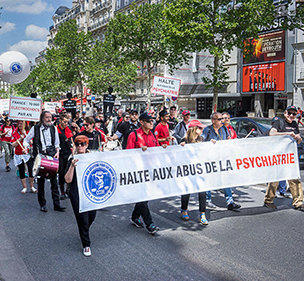Psychiatry: Friend or Foe?

Australia has a population of 24.1 million, yet more than 35 million psychiatric drug prescriptions are written every year, with $9 billion spent annually on mental health.
To counter this, CCHR Australia released the documentary, Psychiatry: Friend or Foe? The Untold Story of Australian Psychiatry. It lays bare Australian psychiatry starting in the 1960s with the infamous “deep sleep therapy.” The practice led to the death of 24 patients over 16 years. Patients were comatose for up to 14 days with large doses of drugs, while concurrently many received electroshocks. A government Royal Commission assigned to investigate the abuses, described deep sleep’s inventor Harry Bailey as “two-faced, devious, dissembling and unprincipled.”
Despite the Royal Commission investigation, Australian psychiatrists continue their destructive practices. Victims of psychiatry are prescribed drugs based on arbitrary evaluations with 90 percent of psychiatrists unable to agree on diagnosis.
Britain’s BBC had 10 volunteers, half of whom had been previously diagnosed with a mental disorder, observed by three mental health experts who were then to determine who had been diagnosed with what. After a week of observation they could get less than half correct. Disorders come from the Diagnostic and Statistical Manual of Mental Disorders, which are created by vote, not by scientific study or evidence. Aileen Wright, a psychiatric nurse said, “People just like to add a label and then they can look across in their book and say, ‘Oh, that’s the drug for that problem, therefore now I know how to treat it.’”
From 1993 to 2012, the Australian government had a 505 percent spending increase on antidepressants, 5,035 percent more on antipsychotics and 12,016 percent more on stimulant drugs. And what do these drugs do to the patients? Barbara Schmidt, a social worker tells us, “All of a sudden they can’t experience life to its fullest, they can’t really feel all that joy when they’re seeing their children.”
“People just like to add a label and then they can look across in their book and say, ‘Oh, that’s the drug for that problem, therefore now I know how to treat it.’”
Add to that the sometimes homicidal and suicidal side effects. One mother was recommended to get her son, distraught over a girlfriend, counseling. After five minutes the psychiatrist he saw concluded, “Looks like he might be depressed, I would recommend Prozac.” Within a month he wasn’t the same. “I barely recognized my son, the child who had been a very high achiever and quite academically gifted, who was loving and compassionate and enormously popular, turned into a child who didn’t want to go to school anymore, who became aggressive and angry all the time. Again and again I went to mental health services and said, ‘I’m really against this, I don’t want him having Prozac,’ and the psychiatrist’s response was to tell me that I should stop reading research and be quiet, that he was the doctor and I was just a mother and I needed to trust his professional judgment,” said his mother. Her son hung himself in the family garage.
The Psychiatry: Friend or Foe? documentary was promoted through TV and a cinema airing, as well as ads in newspapers and on the internet. All promotion directed public to the CCHR Australia website to watch the documentary. All were flanked by a nationwide mailing of the Psychiatry: Friend or Foe? DVD to those directly affected by the psychiatric industry and to key institutions. CCHR Australia reached more than 14 percent of the Australian population with the truth about psychiatric abuse.

STOP PSYCHIATRIC ABUSE
As a nonprofit mental health watchdog, CCHR relies on memberships and donations to carry out its mission. To become part of the world’s largest movement for mental health change, join the group that has helped enact more than 180 laws protecting citizens from abusive psychiatric practices.



